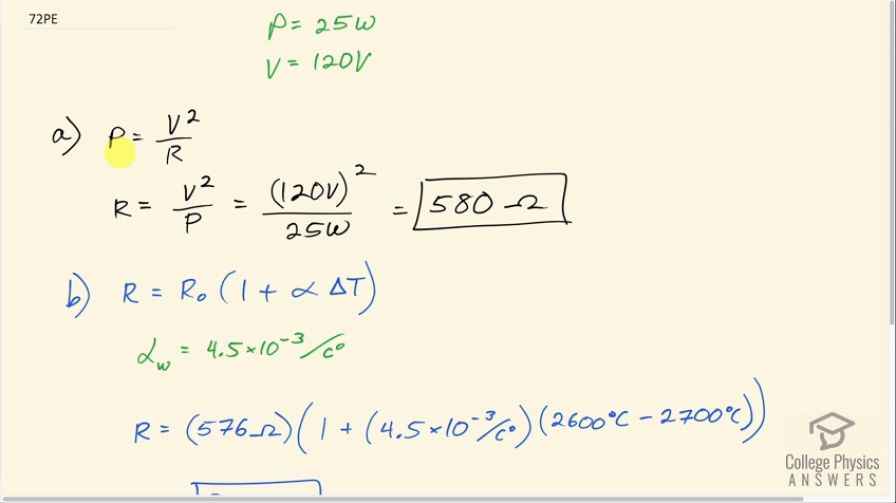Question
(a) What is the hot resistance of a 25-W light bulb that runs on 120-V AC? (b) If the bulb’s operating temperature is , what is its resistance at ?
Final Answer
Solution video
OpenStax College Physics, Chapter 20, Problem 72 (Problems & Exercises)

vote with a rating of
votes with an average rating of
.
Calculator Screenshots
Video Transcript
This is College Physics Answers with Shaun Dychko. A 25.0 watt light bulb runs on 120 volts AC and we are asked what is the resistance of the filament in the light bulb and we are assuming that this is an incandescent bulb with a tungsten filament. So the power is the voltage squared divided by its resistance and we can solve this for R by multiplying both sides by R over P and so resistance then is the voltage squared divided by the power. So that's 120 volts squared divided by 25 watts, which is 580 ohms to two significant figures. In part (b), we are asked what would the resistance of this bulb be if its temperature was reduced to 2600 degrees Celsius assuming that the resistance in part (a) occurs at 2700 degrees Celsius? So this R naught is the original resistance that we know and we found that in part (a)—580 ohms— and it's occurring at 2700 degrees Celsius, we are told, and my choice of letters here is actually a little bit confusing because I have the R here but down here, this is corresponding to R naught and this R is some new resistance— this is gonna be at 2600 degrees Celsius. Okay! We have this formula then that tells us resistance is some original resistance multiplied by 1 plus the temperature coefficient of resistivity multiplied by the change in temperature. So we look up the temperature coefficient of resistivity for tungsten in table [20.2] and it's 4.5 times 10 to the minus 3 per Celsius degree. And so we have this new resistance then is 576 ohms taking, you know, the unrounded answer in our intermediate calculation multiplied by 1 plus 4.5 times 10 to the minus 3 per Celsius degree times the final temperature 2600 degrees Celsius minus the initial temperature of 2700 degrees Celsius and that means the resistance would be 320 ohms.
